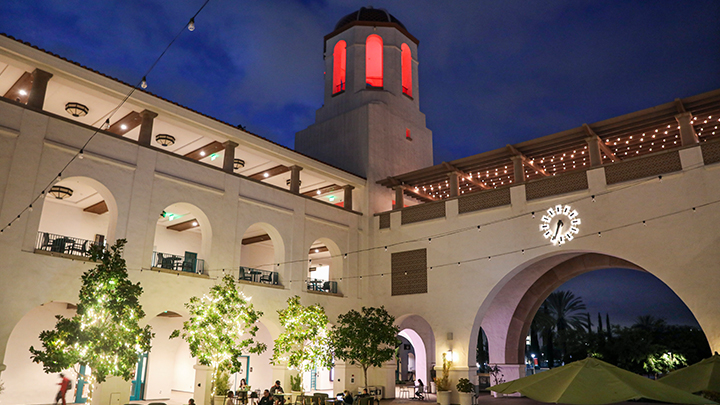Q&A: What powers SDSU, and how do we maintain a sustainable, efficient campus?
Facilities Services executive director Daryn Ockey gives us a peek into how SDSU generates its power, and the work that goes into making sure the campus is running efficiently.

With a student body of more than 39,000 students, San Diego State University is often compared to a small city.
Just as a city of 39,000 would, SDSU relies on a network of utility infrastructure to keep the lights on, and to heat and cool buildings. It’s SDSU Facilities Services’ job to monitor energy production and natural resource consumption to make sure campus infrastructure is operating as efficiently as possible.
Ahead of the 3rd annual Sustainability Summit hosted by the President’s Sustainability Advisory Committee on Wednesday, April 16, SDSU NewsCenter is highlighting different student, faculty and staff-led sustainability efforts on campus. We spoke with Daryn Ockey, executive director of SDSU Facilities Services, to understand some of the technology that keeps SDSU running efficiently.
How does SDSU get its power, and what does the university do to be more energy efficient?
SDSU relies on a cogeneration plant to supply heat and power to our campus. The cogeneration plant produces heat and electricity simultaneously from a single fuel source: natural gas. Unlike conventional power generation, which wastes a significant portion of energy as heat, SDSU’s cogeneration system recaptures heat to provide steam and hot water for campus operations, significantly improving overall energy efficiency. It also provides a layer of resiliency for the campus power supply as it runs independently of our local electric utility.
Since the cogeneration plant was installed in 2001, knowledge around greenhouse gases has increased dramatically, and the university is exploring how it can move away from a natural gas-reliant system. In the meantime, we are working to ensure that we use as little natural gas as possible.
Since 2021, we have been working diligently to optimize our cogeneration plant and have made dramatic improvements in the efficiency of heat and power production. Based upon U.S. Environmental Protection Agency (EPA) guidelines, combined heat and power (CHP) for cogeneration plants should range between 65% and 70%. SDSU’s CHP efficiency was improved from 48% in 2021 to 74.6% in 2023.
Additionally, we are always working to lower our electrical consumption, which lowers the amount of natural gas we use for the cogeneration system and reduces the amount of electricity we buy from SDG&E. Some ways we accomplish this are by changing light bulbs to LED as a routine part of preventive maintenance, resetting HVAC schedules to reflect business hours, increasing our common space “thermostat” to 76 degrees from 74 degrees, and minimizing the use of campus chillers.
Does SDSU use solar panels and are there plans to add more? How much energy does SDSU draw from solar? What percentage of our campus is powered by solar?
Yes, SDSU has solar panels across several buildings and parking structures at SDSU, SDSU Mission Valley and SDSU Imperial Valley. We are currently looking into installing solar arrays on parking structures 3, 4 and 6 at SDSU, and hope to find ways to add solar to other buildings and structures where there is space.
What does SDSU do to limit its trash output and contributions to landfills? Does SDSU have goals to become a zero-waste campus?
SDSU diverts paper, cardboard, aluminum, and plastic from the landfill. We also try, when able, to reduce packaging waste in our purchases. We are in the process of increasing our composting within the offices and we are exploring ways to divert paper waste in the restrooms. Becoming a zero-waste campus is a long-term goal for the university.
What are some ways SDSU manages its water usage? Does SDSU capture rainwater for landscaping? Does SDSU use recycled water?
Just like with energy consumption, SDSU constantly monitors its water usage. The majority of the university’s water consumption is associated with heating and cooling the campus. Facilities Services has implemented several strategies to reduce evaporation within our heating and cooling systems, thus reducing water demand.
One example is our efforts to address water loss at buildings that have damaged underground condensate return piping. By transitioning these buildings to decentralized heating plants, we aim to eliminate unnecessary steam and water losses.
The Conrad Prebys Aztec Student Union has a rainwater collection system. Rain gutters collect water from the roof of the building and funnel it down to 150,000-gallon storage tanks beneath the main courtyard. The free water is later used to irrigate plants.
How does SDSU contribute to greenhouse gas emissions and what are some ways the university is limiting emissions on campus?
SDSU has committed to operational carbon neutrality by 2040 and full carbon neutrality by 2050. A Carbon Neutrality Feasibility Study completed in 2024 showed various pathways to achieve our carbon-neutral goals, pending availability of funding. The highest priority project and biggest opportunity for carbon savings at SDSU is transitioning the cogeneration and steam heating systems to electrified and low-carbon alternatives.
Here are some examples of SDSU’s efforts to minimize emissions on campus:
- Reduced-price Metropolitan Transit System passes offered to students, faculty and staff, as well as carpool incentives.
- Increased bike storage in collaboration with the Office of Housing and Residential Education, and created bike repair stations at University Towers and Chapultepec Hall.
- Contracted with a third party to maintain all existing campus EV stations and to expand the number of EV stations at SDSU, SDSU Mission Valley, and SDSU Imperial Valley at no cost to the university.
Coming in 2025, SDSU will be releasing an updated Climate Action Plan. A status of each of the climate actions identified in the 2017 plan are available on the Climate Action Status Spreadsheet (Updated March 2023 - June 2024).
If a prospective student was considering campus sustainability in their college commitment decision, why should SDSU rank high on their list? Should current students be proud of the efficiency efforts underway at their campus?
SDSU has recently ranked among the Top 50 Green Colleges by Princeton Review. We have a sustainability major and minor program and an environmental science major. We also are incorporating sustainability efforts into our operations, student life, and in research that is conducted in the region.
What else can the campus community do to help with energy efficiency?
We all can do something to help our campus be more sustainable, including turning off lights and equipment when they are not needed, adjusting thermostats, leaving windows closed, and using energy-saving settings on electronics such as printers and computers. If you think there is a way SDSU can be more energy efficient, please do not hesitate to share your concerns with us. If each of us does one small thing, we can have a large impact on the sustainable operation of our campus.



